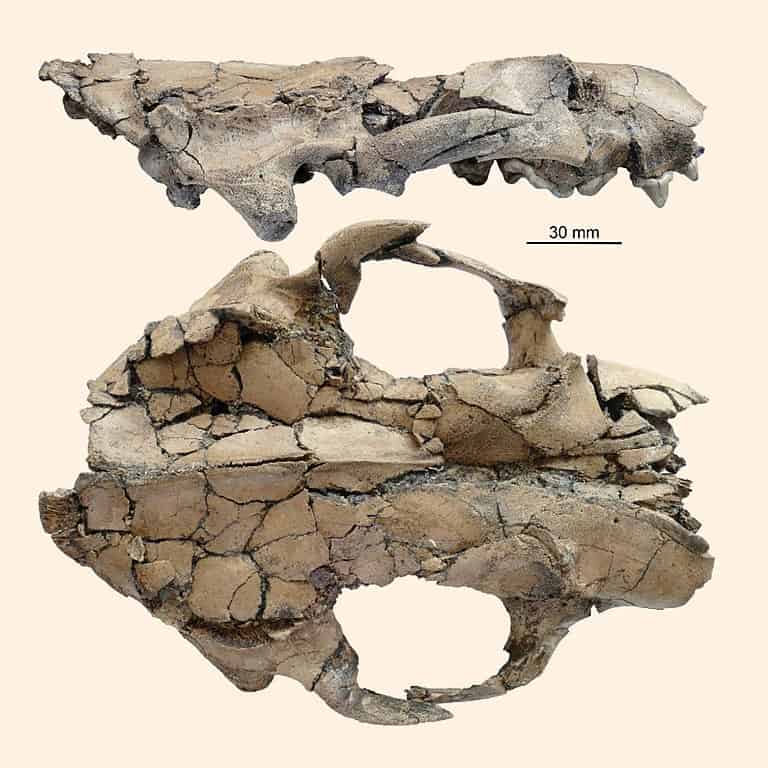Otters are one of the few semi-aquatic mammals worldwide. They do not possess fins or gills but are adept swimmers that hunt on land and in the water. There are 13 known species of otters worldwide, ranging from the Asian small-clawed otters to the six-foot-long giant river otter, the largest. The giant river otter can weigh up to 99 pounds.
Before the giant river otter, there was an otter that weighed more than four times the largest living otter species. This ancient otter weighed as much as an adult lion. Let’s meet the 440-pound otter, the largest otter that ever lived.
Enhydriodon Omoensis: The Largest Otter Ever

The largest otter ever is Enhydriodon Omoensis, weighing over 440 pounds.
©Camille GROHÉ, Kevin UNO, & Jean-Renaud BOISSERIE / CC BY-SA 4.0 – License
Enhydriodon, sometimes referred to as the “bear otter,” is an extinct genus of the Mustelidae family, including otters, wolverines, badgers, and ferrets. These extinct otters roamed the earth from the late Miocene to early Pleistocene epochs, about 10 to 2.5 million years ago.
Various fossil evidence of this giant otter genus have been found, and scientists have classified and named about 11 species of Enhydriodon. Enhydriodon omoensis and Enhydriodon dikikae were the largest otters ever, with omoensis edging out. Enhydriodon omoensis was estimated to weigh more than 440 pounds, which is more than three times the size of the average human.
How Did It Look?
Paleontologists who discovered this genus estimated that these otters would have been as large as modern lions. If these otters still existed, they would have been mistaken for bears more often because of their large sizes. They were hairy and had short snouts and short limbs.
Based on records, the direct descendants of Enhydriodon are sea otters with which they share their bunodont teeth, which are distinctive for molars with rounded or conical cusps. This disparity from the typical otter teeth is one of the many differences between the giants and their modern relatives. However, according to a journal, Enhydriodon were mostly terrestrial, unlike sea otters.
Diet: What Did Enhydriodon Eat?
Like modern otters, Enhydriodon was a carnivore. Otters eat about 15 to 25% of their weight daily. However, these giant otters weighed as much as lions and would have needed more for their size. According to the University of Minnesota, lions consume about 19 pounds daily. However, an adult lion can consume more than 90 pounds, and Enhydriodon might have been capable of consuming as much.
According to Earth, researchers believed Enhydriodon omoensis should have been semi-aquatic like modern otters. However, it was found that these large mammals were not semi-aquatic and fed on terrestrial animals, often herbivores. Enhydriodon had broad incisors, strong canines, and powerful molars capable of crushing, which would have made it easier for them to target a variety of land animals.
Habitat: Where Did Enhydriodon Live?
Based on a news account, Enhydriodon omoensis lived in Africa and Eurasia. The African countries they lived in included modern-day Ethiopia, Kenya, Uganda, South Africa, and Chad. Some species of these large otters also lived in India.
The habitat of the fossil was determined by testing the isotope value of the teeth. According to news reports, the isotope value for Enhydriodon omoensis matched those of the big cats and hyenas that lived in the area.
Predators of Enhydriodon Omoensis
It is reasonable to assume that Enhydriodon did not have many predators. Animals that grow to large sizes are often not preyed upon, granting these mammals the liberty to grow and evolve. Enhydriodon omoensis would have been the least preyed upon if there were predators.
Fossils and Discoveries: When Was It Found?

Fossils of Enhydriodon were found in parts of Asia and Africa.
©Hugh Falconer, Compiled by Charles Murchinson / public domain – License
According to Prehistoric Otter, the first discovery of Enhydriodon was in the 19th century. The first species found was the Enhydriodon sivalensis in the Siwalik Hills of North India. The large species was named by Dr. Hugh Falconer of the British Museum in 1868.
After that discovery, fossils of other species were found, with one of the most recent being Enhydriodon dikikae in East Africa, in 2011. These fossils were found in Kanapoi in Kenya and Dikika in Ethiopia. The fossils of Enhydriodon found included a lower jaw, snout, back of a skull, humerus, and pieces of a femur.
Extinction: When and Why Did Enhydriodon Die Out?
Enhydriodon died out about 3 to 2.6 million years ago, around the Plio-Pleistocene transition, along with many other large carnivores. Little is known about the cause of their extinction, and some quarters believe that the habitats that once served Enhydriodon became unsuitable. According to reports, the period coincided with the African hominid’s evolution and a significant change in climate on the continent.
Other Large Otters That Lived With Enhydriodon
Gigantism was prominent on Earth millions of years ago. There was once a 7.5-ton dinosaur, a 5000-pound alligator, and a bear-sized hyena before humans populated the Earth. Animals grew more than twice the size of their modern relatives. There were other giant otter species besides the Enhydriodon; some are:
1. Siamogale Otters

Siamogale melilutra was a wolf-sized otter that lived about six million years ago.
©Kekerekekere / CC BY-SA 4.0 – License
According to news reports, Siamogale melilutra was a wolf-sized otter that lived six million years ago. A wolf is about two to three times as large as a modern otter, reaching over 100 pounds. Scientists suggested that these large otters had bunodont teeth just like other giant otters because they ate the same prey, causing a common evolution. Siamogale was found in South-West China.
2. Vishnu Otters
According to Earth, another otter ancestor lived about 11.4 million years ago, in the Late Miocene epoch. Vishnuonix neptuni was a mid-sized otter that weighed about 22 to 33 pounds. It was thought to previously exist only in Asia and Africa but was later found in Germany. This suggested that these otters could have been migratory, and the landscapes were different then. Unlike Enhydriodon, Vishnuonix neptuni was largely aquatic and spent only a fraction of its life on land.
Up Next:
Seal vs. Otter: What Are the Differences?
River Otter vs. Sea Otter: 5 Key Differences
Meet the ‘Thick Hyena’ with Stripes that Grew as Big as a Bear
The photo featured at the top of this post is © Hein Nouwens/Shutterstock.com
Sources
- Andrei Ionescu, Available here: https://www.earth.com/news/gigantic-prehistoric-otter-discovered-in-ethiopia/
- andrewsimpson019, Available here: https://prehistoricotter.co.uk/tag/enhydriodon-dikikae/
- ScienceDirect, Available here: https://www.sciencedirect.com/topics/agricultural-and-biological-sciences/enhydra
- Radifah Kabir, Available here: https://news.abplive.com/science/extinct-otter-species-as-huge-as-a-modern-lion-newly-identified-in-ethiopia-enhydriodon-omoensis-1552811
- Science News, Available here: https://www.sci.news/paleontology/enhydriodon-omoensis-11176.html
Thank you for reading! Have some feedback for us? Contact the AZ Animals editorial team.






